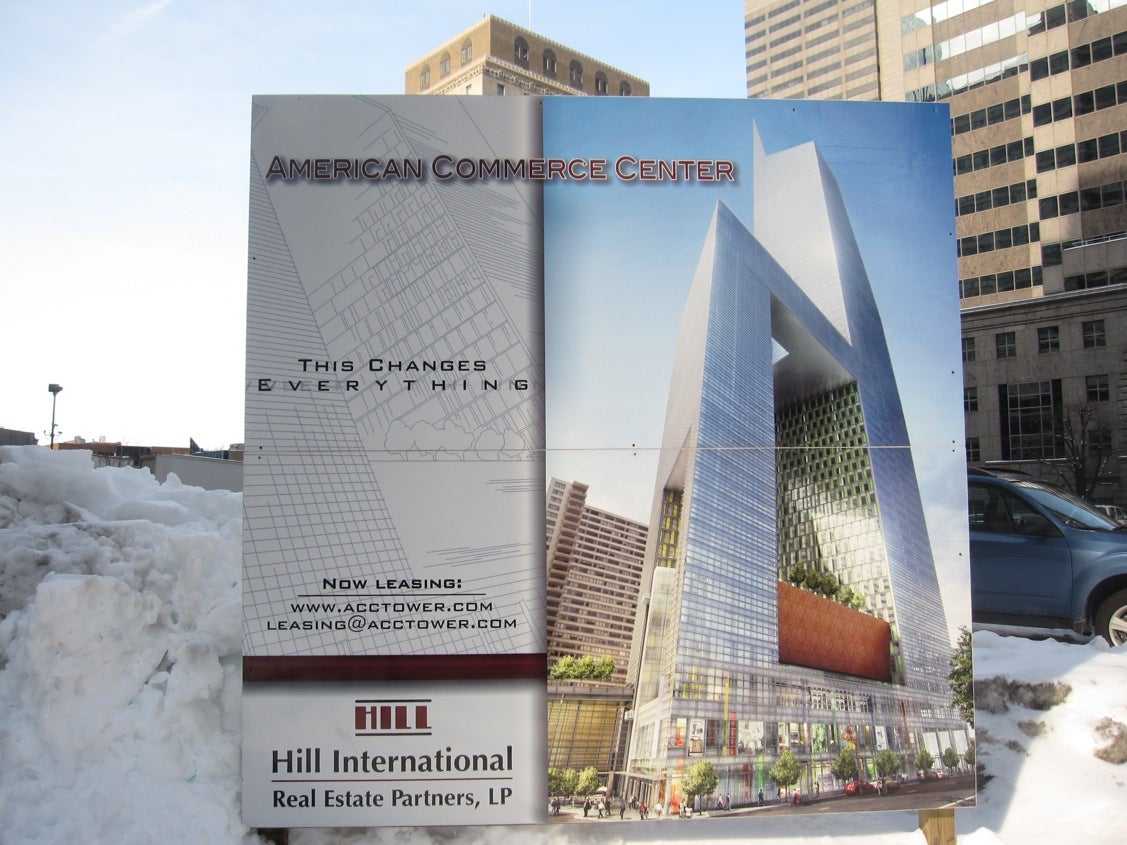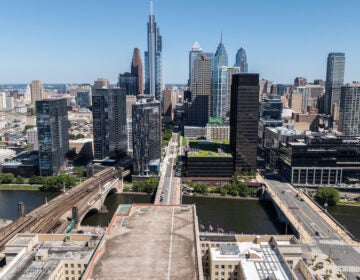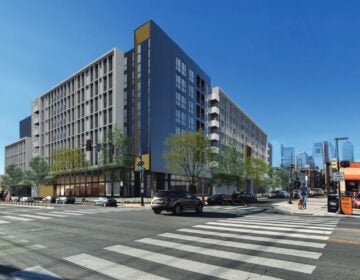Behemoth tower draws crowd, media, Fumo

Massing model / Isaac Steinberg
July 15
By Thomas J. Walsh
For PlanPhilly
During the last few months, the terms “overflow crowds” and “Planning Commission” have been regularly used in the same sentence. And so it was again Tuesday afternoon at the monthly meeting of the commission, but this time, it was no pep rally. Irritable neighborhood groups were joined by television cameras and radio news microphones to hear more about plans for what would be one of the largest buildings in the nation, planned for 18th and Arch streets.
Dozens of residents from the Sterling and Kennedy House apartment buildings and the newer Lofts at 1835 Arch were on hand to listen, snicker, interrupt and comment on the latest details available about the proposed American Commerce Center. A mixed-use, 2 million-square-foot tower that aspires to set a new standard for environmentally friendly design, it would soar above the recently completed Comcast Center as the city’s highest at about 1,500 feet, including a 300-foot spire.
Vince weighs in
With seemingly every media outlet in the city on hand, it was a natural that State Sen. Vince Fumo, nearing the end of his career as a politician, dropped by to offer his definite opinion of the building. He hates it, he said, ultimately labeling the creation of Philadelphia native and world-renown architect Eugene Kohn as “this atrocity.” Interrupting the presentation by developer Walnut Street Capital and Kohn’s firm (evidently with planning chief and Deputy Mayor Andrew Altman’s permission), Fumo started with a more toned-down rhetoric, saying he was “not against this building per se, but I am against this building at this location.”
Perhaps sensing a receptive crowd, he went on to belittle the project’s proponents as “star-crossed” Philadelphians who harbored inferiority complexes, playing a “silly game that we can be better than New York City or Chicago if only we had taller buildings.” They were brief remarks, but he managed to include in them that Gov. Ed Rendell agrees with his views, and that he had a letter from the governor saying that nothing over 500 feet high at the 18th and Arch location would receive any state benefits or tax credits. He then simultaneously thanked and threatened Altman and the rest of the commissioners, gave a nod to the developers and architects, and left to big applause from a sizeable portion of the assembled.
Zoning in on more
Walnut Street Capital, represented by Blank Rome land use and zoning attorney Peter Kelsen (also a member of the Zoning Code Commission), is working on obtaining a zoning remapping ordinance and related amendments to change the site’s commercial district classification and height-limits from what are known as the Benjamin Franklin Parkway Controls. The request includes dramatic increases to rules regarding “floor area ratios” that are aligned with the differing zoning codes. A bill to legislate these changes, along with other specifics, was introduced by City Councilman Darrell Clarke on June 19 (Clarke was not present).
Marty Gregorski, a zoning planner on the Planning Commission staff, said a project’s public benefits (in this case, a substantial lengthening of the Suburban Station underground commuter concourse), sustainability credits (for environmentally conscious construction and maintenance) and economic opportunity points might well earn exemptions on space limits. He also said that if the requested zoning changes were adopted for the American Commerce Center, they would expire in 2013. The “sunset clause” is apparently going to be a new norm for the freshly embolded Planning Commission.
“The zoning is consistent with the buildings around them,” said Kelsen about his client’s request. “It is squarely within the central business core.” It has been essentially a vacant lot for 30 years (it is now a surface parking lot) but was slated for high-rise, high-density development, he said, adding that Kohn Pedersen Fox will bring a unique blend of design and facility to Philadelphia, but with an architectural style that emulates tall buildings being erected and occupied around the world.
Philly boy
“I care about this city,” said the snowy-haired, animated Kohn, a graduate of Central High and the University of Pennsylvania, whom Altman called a “very distinguished Philadelphian.”
“I think it’s also very good that people care and come out to these kinds of events,” Kohn said, nodding to the murmerers in the back. “But it’s also important to care about the city’s future.”
Philadelphia’s skyline was a “tabletop” until very recently, Kohn said, referring to the breaking of the storied “gentleman’s agreement” that kept city structures at or below the brim of William Penn’s hat atop the City Hall tower, until the Liberty Place developments of the mid-1980s. It “was very boring,” he said, asking rhetorically where the city would be, economically, if that imaginary covenant had not been breached. “It would not be good,” he said. (Kohn, employing the charming yet firm eloquence of a prep school headmaster, was clearly playing to the crowd behind the commissioners and reporters. He only slipped up once, attempting a joke about the stock market that was met with slight grins at the front of the room and dead silence in the back.)
“Philadelphia used to be number three [nationally] in size,” Kohn said (Phoenix and Houston have since eclipsed it in population). “The mayor is anxious to give this city a rebirth. … It has to compete not just around the country but around the globe. Tall buildings are important. In the future, cities will have to be super-dense if they are going to survive.” He cited Hong Kong is as the densest city in the world, but also the “most green.”
London, he said, is a medieval city, with narrower streets than in Philadelphia, yet in order to be among the world’s leading financial centers, its skyline is constantly changing. San Francisco and Chicago took similar chances in the face of dissent, he said. And when the Eiffel Tower was built in Paris – Kohn’s PowerPoint switched to a grainy black-and-white image of the iconic obelisk – it was met with “enormous outcry.”
“Not one Parisian today would let you tear that down,” he said. “Not one.”
The historic Philadelphia, the colonial cradle of liberty, embraced change with the City Hall tower, which for eight years was itself the tallest building in the world in the early 20th century, Kohn said. With Liberty Place, the Mellon Bank building and his own Logan Square towers, the city created a modern skyline, he said, and now, the era of the super-dense, super high-rise is upon us.
Comments from the public were mixed, and as is usually the case with a mid-week mid-afternoon public meeting, it was mostly the hard-core for both sides that showed up. The opinions were generally split among the younger residents, particularly at the Lofts at 1835 Arch (“Do you own or rent?” derided more than one opponent, in voices loud enough to be audible but anonymous enough to only be annoying) and more senior residents at the Sterling and Kennedy House.
There were exceptions. The Logan Square Neighborhood Association, as ever, was impressive with its solid preparation and requests for more information. Representatives expressed appreciation for the community involvement so far from Walnut Street Capital, but said firmly that they needed more, much more, particularly with regard to traffic, utilities, shadow studies and other impacts upon their neighborhood.
Boom, here it is
The American Commerce Center is slowly taking on the reputation as a test case for the new planning commissioners, and Mayor Nutter’s emphasis on giving back city planning to the city’s planners. Developers’ first stop, Nutter has declared, is with the department that was once famous for groundbreaking renewal projects and its fiery leader through the 1950s and ’60s, the late Ed Bacon. Bacon managed, seemingly through sheer force of will – in the pre-Internet, pre-cable TV world – to get his mug on the cover of Time Magazine, so inspired were his turnaround projects and planning dreams. It’s hard to imagine what he’d make of this proposal.
But right now, it’s enough that the city’s Planning Commission staff is elated with their newfound relevance. An easy measure of such a claim is the number of city employees willing to soak in a post-lunch three-hour meeting with a bunch of suits and a throng of opinionated neighborhood residents, all of whom are determined to be heard.
“The staff feels … that the ordinance needs some work, especially with regard to the sustainability issues,” said Gary J. Jastrzab, the Philadelphia City Planning Commission’s acting executive director, with more than a whiff of confidence, at the end of the meeting. “I would anticipate taking this back up again at our September meeting.”
Jastrzab repeated the early recommendation that the requested zoning changes to tabled. Seconds later, the motion was put forward and seconded, and Altman adjourned the meeting.
Contact the reporter at thomaswalsh1@gmail.com
WHYY is your source for fact-based, in-depth journalism and information. As a nonprofit organization, we rely on financial support from readers like you. Please give today.






